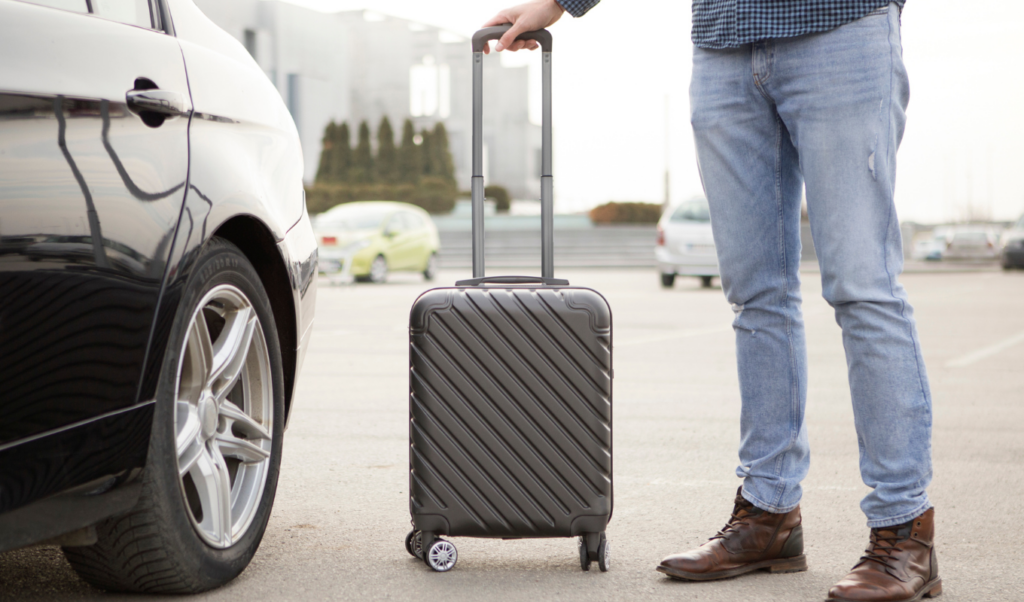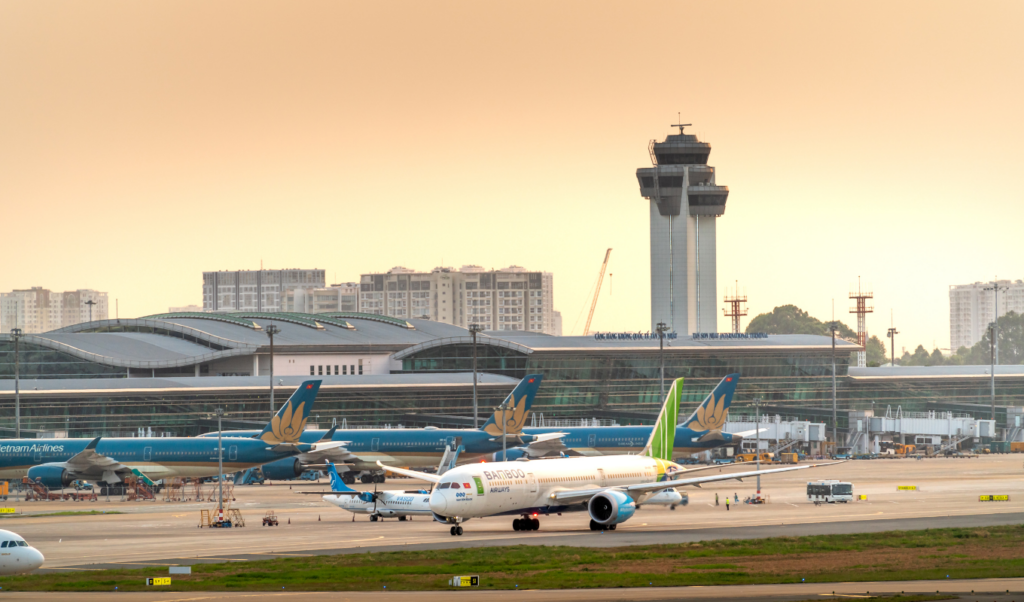Want to save big on flights and transfers? Here’s how:
- Travel on Off-Peak Days: Fly midweek or on Saturdays to save 10-20%. Airports are less crowded, and tickets are cheaper.
- Use Budget Airlines: Book early and avoid extras like seat selection or checked baggage for up to 20% savings.
- Book Multi-City Trips: Combine routes to save up to 30% and explore more destinations.
- Hidden City Ticketing: Skip the last leg of your flight to cut costs by 20-50%. Use tools like Skiplagged.
- Flight Search Tools: Platforms like Google Flights and Kayak help you compare fares and set alerts for deals.
- Set Price Alerts: Track price drops and book at the right time. Alerts can save you an average of $297 per trip.
- Switch Currency/Location Settings: Check fares in the airline’s local currency to save $10-$50 per ticket.
- Throwaway Ticketing: Book multi-leg flights but only travel to the layover city. Savings can reach 47%.
- Save on Airport Transfers: Use public transport, shuttles, or off-airport parking for significant savings.
- Stack Loyalty Programs: Combine airline miles, credit card points, and shopping portals for maximum rewards.
Quick Comparison Table:
| Strategy | Savings Potential | Risks | Ease of Use |
|---|---|---|---|
| Travel on Off-Peak Days | 10-20% | Fewer flight options | Easy |
| Budget Airlines | ~20% | Extra fees for add-ons | Easy |
| Multi-City Trips | Up to 30% | Less flexibility | Moderate |
| Hidden City Ticketing | 20-50% | Airline penalties | Moderate |
| Flight Search Tools | 40-50% | Limited customer support | Easy |
| Price Alerts | Avg. $297/trip | Deals disappear quickly | Easy |
| Currency Switching | $10-$50/ticket | Foreign transaction fees | Easy |
| Throwaway Ticketing | ~47% | Airline restrictions | Moderate |
| Airport Transfers | ~$50/trip | Longer travel time | Easy |
| Loyalty Programs | Up to $625 | Managing multiple accounts | Moderate |
Use these tips to cut costs and make your travel budget go further!

1. Travel on Off-Peak Days
Flying on off-peak days can significantly reduce airfare. Airlines adjust ticket prices based on demand, and understanding these patterns can help you snag better deals. For domestic flights, traveling midweek can save you up to 20%, while international flights departing on a Wednesday or Saturday often come with lower price tags.
Cost Savings Potential
Small changes to your travel schedule can lead to noticeable savings. For instance, choosing a Wednesday departure instead of a Friday for a European trip could cut your airfare by about 10%. Overall, savings typically range between 10% and 20%, depending on your flexibility with dates and routes.
Ease of Implementation
Most flight search engines offer tools to view flexible travel dates, making it easier to spot cheaper options. By tweaking your search to include a range of dates, you can quickly identify opportunities to save. That said, adjusting your travel dates may require some juggling with your schedule.
Risks or Trade-offs Involved
While traveling on off-peak days can lower costs, there are a few trade-offs to consider. Early morning flights, for example, might save you money but could leave you waiting for your hotel check-in. To avoid this inconvenience, contact your hotel in advance to ask about early check-in or luggage storage options. On the other hand, late evening departures might give you a relaxed morning but could shorten your time at your destination or complicate transportation. Pre-booking transfers can help you avoid the hassle of navigating late-night arrivals. Additionally, off-peak days may have fewer flight options, which could mean dealing with inconvenient layovers or limited schedules.
Additional Perks or Benefits
Traveling during off-peak times isn’t just about saving money – it can also make your trip more enjoyable. Airports are less crowded, which means shorter lines and a smoother overall experience, especially for families or travelers who need extra assistance. Once you arrive, destinations are often quieter too, with shorter lines at attractions and more attentive service.
2. Use Budget Airlines Effectively
Budget airlines can be a game-changer for travelers looking to save on airfare. These carriers strip away nonessential perks to offer low fares, making them a great option for those willing to trade a bit of comfort for extra cash in their pocket. But to truly benefit, you need to understand how these airlines operate and plan accordingly.
Cost Savings Potential
Flying with budget airlines can cut your ticket costs by about 20% compared to traditional carriers. Early bookings often yield even bigger discounts, as these airlines keep prices low by eliminating extras like reclining seats and free snacks. For perspective, the average domestic round-trip ticket price in the U.S. dropped from $647.94 in 1990 to $420.70 in 2019 (adjusted for inflation). Globally, low-cost carriers now handle over half of all scheduled flights in many regions.
However, budget airlines often rely on add-on fees, so understanding their pricing structure is crucial. Here’s a quick comparison:
| Feature | Budget Airlines | Full-Service Airlines |
|---|---|---|
| Base Fare | Lower initial prices | Higher upfront costs |
| Checked Baggage | $50–100 per bag | $35–40 for the first bag |
| Carry-on Bags | Up to $99 at the gate | Usually included |
| Seat Selection | $5–50 | Often included or $50–150 for premium seats |
| Flight Changes | $35–65 online | Some offer free changes |
| Airport Check-in | $30–55 fee | Usually included |
Ease of Booking
Booking with budget airlines is straightforward and efficient. Most use streamlined online systems and operate with uniform fleets, which keeps training and maintenance costs down. They also avoid traditional ticketing, relying on digital solutions to simplify the process. To snag the best deals, book as early as possible – fares tend to climb as the departure date approaches. If you’re a frequent flyer, consider subscription programs like Frontier Airlines’ Discount Den, which offers perks such as exclusive fares for an annual fee of $59.99.
Trade-offs to Keep in Mind
While the savings can be tempting, budget airlines come with some compromises. Delays and cancellations are more common due to tight schedules and limited backup planes. Many of these carriers also operate from secondary airports, which can mean longer travel times and added transportation costs. Customer service may be limited, making it harder to resolve issues. Additionally, policies for changes or cancellations are often strict, and seating can be cramped as airlines prioritize maximizing capacity.
Extra Benefits to Consider
Some budget airlines are stepping up their game by offering loyalty programs focused on affordability and convenience. For instance, Frontier Airlines’ Discount Den not only provides access to lower fares but also allows you to book discounted tickets for up to eight people on the same reservation. These programs can add significant value for frequent flyers.
The secret to making budget airlines work for you? Plan ahead. Factor in all potential costs – including fees – and be flexible when it comes to delays or secondary airport locations. With the right approach, you can enjoy substantial savings without too much hassle.

3. Book Multi-City Trips
If you’re looking to stretch your travel budget, multi-city bookings can be a game-changer. By bundling separate one-way flights into a single itinerary, you can often snag significant savings while exploring multiple destinations.
Cost Savings Potential
Multi-city bookings are particularly cost-effective for long-haul international travel. Instead of booking separate one-way tickets, combining them into a multi-city itinerary can save you a considerable amount of money. For example, a ticket from Chicago to Frankfurt to London costs $1,874 as a multi-city booking, compared to $3,436 if booked separately – a difference of over $1,500.
Flexibility with your travel dates can further boost savings, sometimes cutting costs by up to 30%. Plus, focusing on flights within the same airline alliance often leads to more competitive pricing. Once you spot these savings, modern booking tools make it easy to lock in your plans.
Ease of Implementation
Thanks to advanced search tools, booking a multi-city trip is now a straightforward process. You can combine flights seamlessly into a single reservation, simplifying your itinerary.
Another perk? You can turn long layovers into stopovers, giving you a chance to explore an extra destination without breaking the bank. It’s a simple way to add more adventure to your journey while keeping costs in check.
Risks or Trade-Offs
While the savings are tempting, multi-city bookings come with a few caveats. One key issue is flexibility – or lack thereof. If you need to change one segment of your trip, it could lead to fees or complications across the entire itinerary. About 20% of these trips experience delays, and 25% encounter luggage issues. Additionally, varying baggage policies between airlines can result in unexpected fees or hassles.
Because of these limitations, it’s essential to commit firmly to your travel dates and destinations before booking.
Additional Perks or Benefits
Beyond saving money, multi-city bookings offer exciting opportunities for those who love to explore. You can plan efficient routes that reduce time in the air while maximizing the destinations you visit – a strategy that works exceptionally well in regions like Europe or Southeast Asia, where countries are close together.
Another major advantage is convenience. With all your flights bundled into one reservation, you only have to manage a single confirmation and set of terms. This unified approach often includes coordinated customer service, which can make the entire process less stressful.
In short, multi-city bookings allow you to explore more of the world without blowing your budget. They’re a smart choice for adventurous travelers looking to make the most of their journeys.
4. Use Hidden City Ticketing
Hidden city ticketing, often called “skip-lagging”, is another clever strategy to help you trim airfare costs. This approach involves booking a multi-leg flight where your desired destination is actually a layover, and then skipping the final leg of the journey. It takes advantage of the sometimes-odd pricing structures airlines use, where connecting flights can cost less than direct ones. While it’s not without its risks, it can be a game-changer for those looking to stretch their travel budget.
Cost Savings Potential
The savings from hidden city ticketing are nothing to scoff at. Travelers often save between 20–50% on airfare, with some routes offering discounts as high as 70%. For example, in March 2025, a direct United flight from Honolulu to Newark was priced at $763. However, booking a Honolulu–Newark–Orlando ticket and skipping the last leg brought the cost down to just $216 – a savings of over $500. Another traveler managed to shave $100 off a San Francisco–Seattle trip by booking a flight to Portland with a Seattle layover, paying $200 instead of $300. Even international business class travelers can benefit. A Perth to Sydney flight might cost A$2,520, but a Perth–Auckland ticket (with a Sydney layover) could be just A$1,020.
How to Get Started
Finding hidden city deals takes a bit of digging, but it’s doable. Start by comparing fares for flights that include your desired destination as a layover versus direct flights. Tools like Skiplagged are specifically designed to help you spot these opportunities and calculate potential savings. Being flexible with your travel dates and opting for one-way tickets can also increase your chances of finding a great deal.
Risks and Downsides
While the savings are tempting, hidden city ticketing comes with its share of risks. The biggest issue? Checked luggage. Since your bags are sent to the final destination, this strategy only works if you’re traveling with carry-on luggage. Airlines might also penalize you if they catch on. They could cancel unused segments, void refunds, or even charge you the full fare difference. There’s also the risk of flight delays or cancellations. If your layover destination gets bypassed, you could end up stranded without an easy way to reach your intended stop.
Extra Benefits
Aside from saving money, hidden city ticketing can sometimes open up routes and fare options that aren’t available through standard booking methods. According to Hopper Research, hidden city opportunities appear on 26% of domestic routes, with fares averaging 21% less than direct flights. While airlines include clauses in their contracts requiring passengers to complete their full itinerary, enforcement is inconsistent. For savvy travelers willing to accept the risks, this strategy remains a viable option. Combined with other cost-saving methods, hidden city ticketing can be a powerful tool for budget-conscious travelers looking to make the most of their trips.

5. Use Flight Search Tools
Flight search tools gather data from various airlines, allowing you to compare fares quickly and efficiently. This method simplifies your search process and saves time.
Google Flights is a popular option for finding budget-friendly flights. It directs you to book directly with airlines or online travel agencies without any extra charges. Plus, it offers features like searching multiple airports at once, viewing fares across an entire month, tracking price changes, and using its Explore map to discover unexpected destinations.
Other helpful tools include Kayak, Skyscanner, Momondo, and Dollar Flight Club. For instance, Dollar Flight Club provides email and SMS alerts about discounted flights, offering members access to exclusive deals.
Cost Savings Potential
Using flight search tools can lead to significant savings. According to Expedia’s 2025 Air Hacks Report, booking domestic flights one to three months in advance can save up to 25% compared to last-minute bookings. A 2024 Google study found that the best time to book domestic U.S. flights is about 38 days before departure, while international flights are most affordable when booked 101 days ahead. Price alerts for European destinations have reportedly saved travelers an average of 43%.
Ease of Use
Getting started with these tools is simple. Most platforms are user-friendly, making it easy to compare prices. Expanding your search to include nearby airports and staying flexible with travel dates can help you uncover even more savings.
Potential Drawbacks
While flight search tools are undeniably convenient, there are a few downsides to consider. Limited customer support from third-party sellers can make resolving issues more challenging. Some platforms may show “ghost fares” – prices that are no longer available when you try to book – and smaller online travel agencies found through these tools may not always have the best reputations. Additionally, budget airlines might not appear in search results, so it’s worth checking their websites directly. Changes made through third-party sellers can also come with higher fees, and you might not receive timely updates about flight changes.
Added Benefits
Beyond saving money, these tools can enhance your travel planning. For example, Google Flights offers a Travel Planner feature that helps organize itineraries, track price changes, and even recommend hotels. It can also guide you toward flights with lower carbon emissions and help you choose the best seats on your flight.
6. Set Up Price Alerts
Price alerts are a lifesaver for travelers who want to snag deals without constantly refreshing flight search pages. These tools scan fare changes across multiple airlines and notify you via email or SMS when prices drop on your selected routes.
How Price Alerts Can Save You Money
Price alerts are more than just convenient – they can lead to serious savings. In 2024, travelers using these tools saved an average of $297 per trip, with international trips seeing a 37% boost in cost savings. Alerts for European routes were particularly effective, delivering 43% more savings compared to those for Asia Pacific. On average, users booked flights 31 days earlier than those who didn’t use alerts. Interestingly, mobile apps outperformed desktop alerts, catching deals 22% more often.
Setting Up Alerts Is Easy
Platforms like Google Flights, Kayak, Skyscanner, and Dollar Flight Club make it simple to create price alerts. Dollar Flight Club, for example, sends both email and SMS notifications for discounts that can go up to 90% off domestic and international flights. To increase your chances of finding the best deals, consider setting up alerts for multiple nearby airports.
Things to Watch Out For
While price alerts are handy, they can also clutter your inbox if you’re tracking multiple routes. Fare deals can appear and disappear quickly, so you’ll need to act fast when a notification comes through. Additionally, no single platform catches every deal, so relying solely on alerts might mean missing out on some opportunities. Many premium alert services charge a subscription fee, typically under $100 annually.
Extra Benefits
Beyond savings, price alerts can help you spot fare trends, mistake fares, and limited-time flash sales. Services like Dollar Flight Club even offer additional perks like exclusive deals, travel discounts, and partnerships with top brands. These extras can make it easier to plan trips to bucket-list destinations or jump on unexpected bargains. Plus, some platforms let you monitor fares even after booking, giving you a chance to rebook if prices drop.

7. Switch Currency and Location Settings
Did you know airlines often charge different prices for the same ticket based on the buyer’s location and currency? This opens up a chance to save money by simply tweaking your location and currency settings when booking flights. Airlines use varying methods to convert prices into foreign currencies, and exchange rate fluctuations can lead to price differences across regions.
To try this trick, open two browser windows – one set to your actual location and currency, and the other set to the airline’s home country and currency. Run the same search in both windows, then compare the results to find the better deal. You can also check the airline’s native website to view prices in the local currency. If the language is a barrier, Google Chrome’s built-in translation feature can help. This approach works well alongside other price-tracking strategies by exposing regional fare differences.
Cost Savings Potential
Switching currency and location settings can lead to noticeable savings. For example, in 2019, a flight from Chiang Mai to Phuket cost $124.84 when searched in U.S. dollars, but the same AirAsia flight was listed at 3,384.70 Thai Baht (around $106.04 USD), saving about $20. That same year, a Bangkok Airways flight from Bangkok to Phuket was $70 in USD but only 1,458 THB (approximately $45.69), saving about $25. Another example from 2017 showed a Norwegian Air flight from Dubrovnik to Bodo priced at $310 on the U.S. website, but only 2,474 Norwegian Krone (about $292) on the Norway site, saving $18.
Ease of Implementation
This method is easy to incorporate into your flight search routine. On Google Flights, click the three horizontal lines near the Google logo, then scroll down to adjust the language, currency, or location. On booking platforms like Expedia, navigate to the “Global Sites” section at the bottom of the page and select the flag for your target country. No special tools are needed – just use Chrome’s translation feature to compare prices across regions.
Risks or Trade-offs
While this strategy can save you money, there are some trade-offs to consider. Exchange rates can fluctuate, and foreign transaction fees – sometimes as high as 14–17% at airport exchanges – can cut into your savings. Additionally, airlines use dynamic pricing, meaning fares can change quickly based on demand. If you find a deal, it’s best to act fast to lock it in.
Additional Perks or Benefits
Beyond saving money, this technique can give you a better understanding of global pricing trends and might even help you spot mistake fares or regional discounts. For the best results, pair this hack with a credit card that doesn’t charge foreign transaction fees. This way, you can maximize your savings without worrying about extra charges.
8. Use Throwaway Ticketing
Throwaway ticketing is a clever way to save on airfare by booking a multi-segment flight but only traveling to the layover destination, which happens to be your intended stop. Airlines often price multi-leg flights lower than direct routes, creating opportunities for savvy travelers to cut costs. However, this strategy comes with its own set of challenges and risks that you’ll need to navigate carefully.
How Much Can You Save?
The savings with throwaway ticketing can be impressive. According to Skiplagged.com, travelers save an average of 47% – roughly $180 – on these kinds of flights. The platform also reports that nearly 300,000 travelers have used this approach, collectively saving $51 million.
For instance, a direct flight from the West Coast to St. Louis might cost $564. But if you book a flight to Atlanta with a layover in St. Louis, you could pay as little as $198, saving $366. Another example: a Newark to Salt Lake City flight with a layover at LAX costs $147, while a direct Newark to Los Angeles flight is priced at $160 – saving you $13.
How to Make It Work
Successfully pulling off throwaway ticketing takes some forethought:
- Stick to one-way tickets: This prevents the airline from canceling your return flight if you skip a segment.
- Carry-on only: Checked baggage will be routed to the final destination, which you won’t reach.
- Frequent flyer miles: Consider using a partner airline’s loyalty program to make tracking your activity harder.
This strategy works best when your layover city is a major hub like Atlanta, Denver, Chicago, or Dallas – destinations with plenty of connecting flights.
Risks You Should Know About
While the savings can be tempting, throwaway ticketing isn’t without its risks. Airlines can take action against passengers who skip segments, including canceling unused portions of the ticket, voiding refunds, and restricting future baggage check-ins. In some cases, they may even charge the full itinerary cost. Frequent flyer accounts can also be canceled, or worse, passengers might be blacklisted.
There have been high-profile cases, too. In 2019, Lufthansa sued a passenger for skipping a leg of their journey, seeking repayment of 2,112 euros (about $2,362) plus interest. More recently, in 2023, a teenager was briefly detained by American Airlines for using this tactic. Airlines may also rebook you on a nonstop flight, bypassing your intended layover and leaving you stranded.
Additional Things to Consider
Aside from the cost savings, throwaway ticketing can sometimes offer better flight times or more route flexibility. However, the ethics of this practice remain a topic of debate.
That said, Aktarer Zaman, the founder of Skiplagged, points out that in 11 years of operation, he hasn’t heard of anyone being permanently banned for skiplagging. Over the past year alone, approximately 300,000 customers have used the service without major issues.
While throwaway ticketing can lead to substantial savings, it demands careful planning and an understanding of the potential complications to ensure a smooth experience.

9. Save on Airport Transportation
While scoring flight deals is often the focus of travel savings, cutting down on airport transportation costs can also make a big difference. With a bit of planning, you can avoid spending more than necessary on getting to and from the airport.
Cost Savings Potential
Saving on airport transportation can add up, especially for longer trips. For instance, parking at Seattle’s Sea-Tac Airport costs $28 per day or $130 for a week. However, using discount coupons from the airport’s website can lower this to $19 per day or $99 per week.
Off-airport parking can save you even more. At Park-N-Jet Lot 1 near Sea-Tac, parking costs just $5.39 per day, totaling $41.46 for a week, including fees. That’s less than the cost of two days of general airport parking.
Public transportation is often the cheapest option. In Seattle, the Sound Transit Light Rail charges adult fares between $2.25 and $3, depending on where you board. Compare that to rideshare services like Uber or Lyft, which can cost $50–$150 each way from Huntington Beach to LAX.
Shared shuttles strike a balance between affordability and convenience. For example, Land to Air Express offers one-way tickets for $11 to $25, while Alsaab Transportation’s carpooling services can cut costs by as much as 70% compared to taxis.
Ease of Implementation
Once you’ve identified a cost-effective option, putting it into action is simple. Booking shuttle services in advance is quick and often comes with discounts.
Public transit routes to airports are well-established and easy to navigate. For example, taking the Metrolink train from Anaheim to Union Station costs about $9, and the Union Station Flyaway Bus adds $9.75 – still far cheaper than most rideshares.
Off-airport parking reservations are also easy to make online. Many lots provide free shuttles, 24-hour security, and flexible payment options, with some requiring a deposit and others charging upfront.
Risks or Trade-offs Involved
While cheaper options can save money, they often come with trade-offs. Shuttle services follow fixed schedules, which might not align perfectly with your plans, and stops for other passengers can add time to your trip. Some services might also charge extra for luggage.
Public transportation, though affordable, can be less convenient if you’re traveling with multiple bags or are short on time. Rideshare services offer flexibility but can be subject to surge pricing during peak periods, while taxis tend to be more expensive overall.
If you’re driving and using off-airport parking, remember to account for potential traffic delays and the time needed to transfer to the terminal via shuttle. Allowing extra time for these factors can help minimize stress.
Additional Perks
Many budget-friendly transportation options come with added benefits. Off-airport parking lots often include free 24/7 shuttles and enhanced security features that sometimes surpass those at on-site airport lots.
Frequent travelers can take advantage of loyalty programs offered by transportation services, which provide ongoing savings and perks. Some credit cards also offer rewards or cashback for travel-related expenses like airport rides.
Additionally, airport hotels often offer “park, sleep, and fly” packages, which can be a great option if you have an early morning flight. If you’re using rideshares, walking to a nearby hotel or less congested area for pickup can sometimes reduce your fare.
10. Stack Loyalty Programs
Stacking loyalty programs is a smart way to stretch your travel budget by combining rewards from different programs to maximize savings. When paired with savvy booking techniques and price alerts, this strategy can significantly reduce your travel expenses.
Cost Savings Potential
By stacking rewards from flights, hotels, and car rentals, travelers can save up to $625 compared to booking each component separately. Some frequent travelers even report discounts of 30% or more on flights by leveraging credit card offers, portal promotions, and bundled deals.
Ease of Implementation
Getting started is easier than it sounds. Sign up for airline loyalty programs and their co-branded credit cards, ensuring the name matches your credit card exactly to avoid transfer issues. Link your loyalty accounts for quick point transfers, but wait to transfer points until you’re ready to book a specific flight or hotel. Always compare the value of booking through your credit card’s travel portal versus transferring points directly to partners.
The key is to start small. Begin with one airline and one hotel program, then gradually add more cards and shopping portals as you become comfortable with the process. Over time, you’ll develop a system that works best for your travel needs.
Risks or Trade-offs Involved
Managing multiple loyalty programs can get tricky. On average, U.S. households have about 18 loyalty program memberships, but more than half of those accounts go unused. This can lead to scattered, unusable point balances, make it harder to achieve elite status, and increase exposure to security risks.
To avoid these pitfalls, focus on one or two loyalty programs to build a meaningful balance faster and potentially reach elite status. Regularly monitor all account activity for suspicious behavior, and enable security measures like two-factor authentication to protect your accounts.
Additional Perks or Benefits
Stacking rewards doesn’t just save money – it opens up opportunities for double-dipping. For instance, you can use both credit card rewards and loyalty program points on the same purchase. Combining offers, like Amex Offers with hotel loyalty programs, can lead to even greater savings.
Transferring credit card points to airline and hotel partners often provides better value than cash-back redemptions. To get the most out of your points, keep an eye on promotions and loyalty program trends, and time your transfers strategically. Diversifying your points across multiple programs can also give you more flexibility while reducing risks.
Travel flexibility is another game-changer. Adjusting your travel dates by just a few days or weeks can lead to significantly lower redemption requirements. When combined with thoughtful program stacking, this strategy can turn your everyday expenses into considerable travel savings.

Cost Comparison Table
Booking strategies can greatly impact your travel expenses. From budget airlines to hidden city ticketing and currency switching, each approach has its own costs, savings, and risks. Let’s break it down.
In 2022, passengers collectively paid about $6.8 billion in baggage fees. Shockingly, these fees sometimes exceed the ticket price itself.
Here’s a comparison of common booking strategies:
| Strategy | Potential Savings | Additional Costs | Risk Level |
|---|---|---|---|
| Budget Airlines | Lower base fares | Extra fees for baggage (e.g., carry-on: $34–$60 on Frontier; checked: $50+ on Spirit) | Low |
| Hidden City Ticketing | 20–50% off the ticket price | $10 Skiplagged booking fee | High |
| Currency Switching | $10–$50 per person | Possible foreign transaction fees | Low |
| Full-Service Airlines | Baggage often included | Higher base fares | Low |
| Southwest Airlines | Two free checked bags | Higher base fares | Low |
Baggage Fee Breakdown by Airline
Baggage fees vary widely across airlines. Here’s a snapshot of what you might pay:
| Airline | First Bag | Second Bag | Carry-on Policy |
|---|---|---|---|
| Alaska Airlines | $35 | $45 | Free with most fares |
| American Airlines | $35–$40 | $45 | Free with most fares |
| Delta Air Lines | $35 | $45 | Free with most fares |
| Frontier Airlines | $55–$100 | $73–$94 | $34–$60 fee |
| JetBlue | $35–$40 | $50–$60 | Free with most fares |
| Southwest Airlines | Free | Free | Free |
| Spirit Airlines | Varies (starts at $50) | Varies | Fee applies |
| United Airlines | $35–$40 | $45–$50 | Not free with basic economy fares |
Key Insights on Savings and Risks
Hidden city ticketing can slash ticket prices by 20–71%. For instance, a March 2025 United flight dropped from $763 to $216, while an American Airlines route saved travelers 65%. However, this strategy comes with risks. Airlines may penalize passengers, as seen in a 2023 case involving American Airlines.
Currency switching is another way to save. For example, an AirAsia flight from Chiang Mai to Phuket dropped from $124.84 USD to $106.04 when booked in a different currency. While savings of $10–$50 per person are common, foreign transaction fees should be considered.
Choosing the Right Strategy
The best booking method depends on your travel style. Budget airlines work well for light packers, while families might appreciate Southwest’s free baggage policy. Hidden city ticketing is an option for risk-tolerant travelers seeking big discounts, and currency switching offers steady savings with minimal effort. Evaluate your priorities and pick the strategy that aligns with your needs.
Conclusion
Scoring cheap flights and transfers isn’t about luck – it’s about smart planning and flexibility. Savvy travelers use a mix of strategies to stretch their budgets further. Start by targeting flights on days when fares typically drop, like Tuesdays, Wednesdays, or Saturdays. Take advantage of flight search tools with features like “Explore” maps to uncover unexpected deals from your local airport, and set up fare alerts to automatically track price changes.
For even more savings, explore options like open-jaw flights, multi-city itineraries, or piecing together separate one-way tickets. Adjusting your currency and location settings can also reveal discounts that might otherwise go unnoticed.
By layering these strategies, you can save more than with standard booking methods. For instance, pairing off-peak day bookings with currency adjustments and hidden city ticketing can lead to substantial cost reductions.
To make deal-hunting even easier, services like Dollar Flight Club can be a game-changer. They send curated flight alerts right to your inbox, focusing on mistake fares and exceptional deals from your home airport. With premium memberships starting at $69 per year, this tool can save you time and potentially pay for itself with just one big-ticket booking. It’s an efficient way to complement your fare alert strategies without the hassle of managing multiple alerts manually.
FAQs
What are the risks of hidden city ticketing, and how can you reduce them?
Hidden city ticketing, also known as skiplagging, comes with a fair share of risks that travelers need to weigh carefully. Airlines strictly prohibit this practice, and the consequences can be severe. You might lose your frequent flyer miles, face additional fees, or even get banned from flying with that airline. On top of that, if you’ve checked luggage, it will usually be sent to the final destination on your ticket – not where you plan to stop – throwing a wrench into your travel plans.
To reduce these risks, stick to carry-on luggage and book only one-way tickets. Skipping a leg on a round-trip ticket could lead to the airline canceling your return flight entirely. It’s also smart to familiarize yourself with the airline’s ticketing policies so you’re aware of what could happen. This strategy should be used sparingly and only if you’re ready to handle the potential fallout.
What’s the best way to combine loyalty programs to save more on travel?
To get the most out of your travel budget, consider joining loyalty programs offered by your favorite airlines and hotels. These programs are typically free to join and come with perks like earning points or miles for your bookings.
Pairing these programs with a travel rewards credit card can take your savings even further. These cards let you rack up additional points on flights, hotel stays, and other travel expenses, giving you more bang for your buck.
For an extra boost, take advantage of shopping portals associated with your loyalty programs. These portals allow you to earn bonus points on everyday purchases, from groceries to online shopping. Also, keep an eye out for limited-time promotions or bonus point offers – they can make a noticeable difference in your rewards. By layering these strategies, you can maximize your points and stretch your travel dollars further.
What are the downsides of flying with budget airlines, and how can I avoid extra fees?
Flying with budget airlines can be a great way to save money on airfare, but those savings can quickly shrink when hidden fees come into play. Extra charges often pop up for things like carry-on or checked bags, choosing your seat, or even grabbing a snack or drink mid-flight. For instance, paying for baggage at the airport can cost anywhere from $30 to $45 – often more than if you had paid online in advance.
To keep these costs in check, take a few simple steps. Start by reviewing the airline’s fee structure before booking your ticket, so you know exactly what to expect. Pack light to stick within the free personal item allowance, and if you need to pay for extras like checked luggage or seat selection, do it upfront during the booking process to lock in lower rates. You might also want to explore loyalty programs or travel credit cards that come with perks like free checked bags, helping you save even more.










